We may not have the course you’re looking for. If you enquire or give us a call on +61 272026926 and speak to our training experts, we may still be able to help with your training requirements.
Training Outcomes Within Your Budget!
We ensure quality, budget-alignment, and timely delivery by our expert instructors.
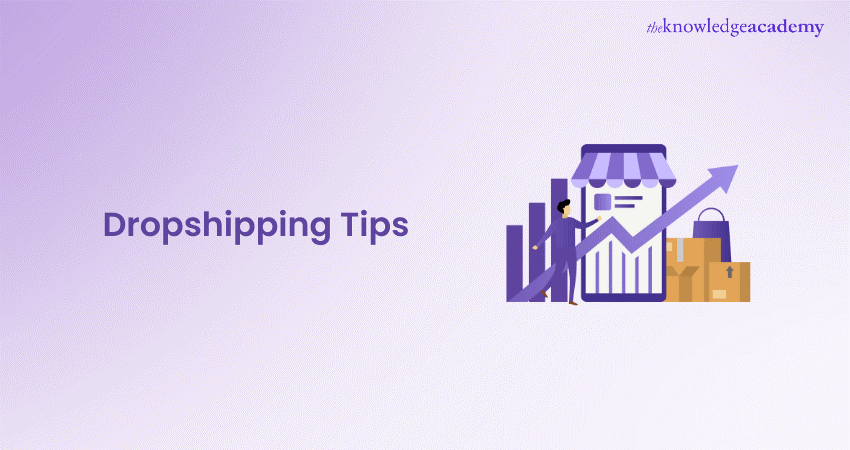
What makes some Dropshipping ventures thrive while others struggle? How can entrepreneurs use Data Analytics and smart decisions to succeed? Explore these 13 Dropshipping Tips and unlock the potential of your business with actionable insights and expert guidance.
In addition, this blog dissects Dropshipping, offering insights to demystify running a successful enterprise. From leveraging Data Analytics to strong supplier partnerships, each Dropshipping Tip empowers you with knowledge and tools to thrive in e-commerce. Dive in for a game-changing journey!
Table of Contents
1) Top Dropshipping Tips
a) Use Data Analytics
b) Price your products effectively
c) Adopt simple shipping rules
d) Monitor your inventory
e) Prioritise marketing
2) Conclusion
Top Dropshipping Tips
The following are the best Dropshipping Tips designed to optimise your business operations and enhance your success in the competitive world of e-commerce.
1) Use Data Analytics
Data Analytics is a powerhouse tool for enhancing your Dropshipping business by illuminating key insights into market trends, customer preferences, and product performance. By using tools like Google Analytics and Shopify reports, you can analyse customer demographics and purchasing behaviours effectively. This data provides a clear picture of who your customers are, what they prefer, and how they navigate through your website.
Strategic decision making:
By harnessing this wealth of information, you can make strategic decisions about your inventory and pricing strategies. Data Analytics can assist you in identifying which products are performing well, allowing you to optimise your stock levels accordingly. Adjust pricing based on demand elasticity to stay competitive and maximise profits in Dropshipping.
Optimising marketing efforts:
Understanding how customers interact with your website highlights which marketing campaigns are most effective, guiding you to invest more wisely in future advertising. By specifically customising your offers to match their demands, this tailored approach improves customer happiness while boosting conversion rates.
2) Own your supplier's mistakes
Here are the methods to handle mistakes made by your suppliers in Dropshipping:
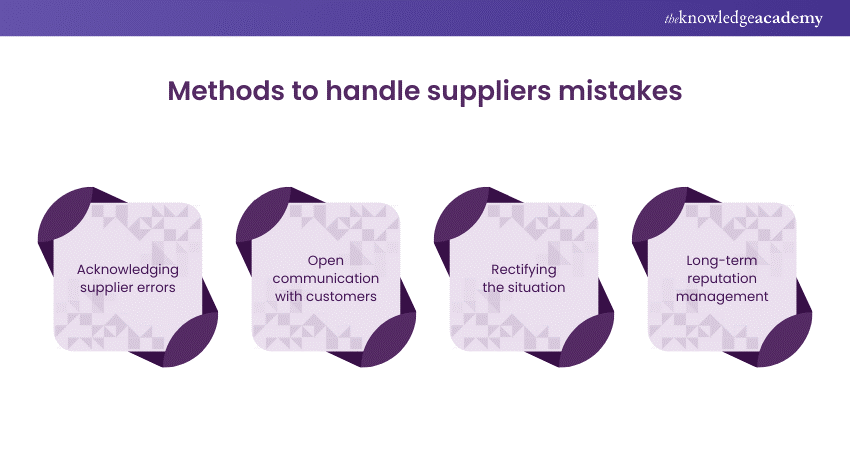
Acknowledging supplier errors:
In the dynamic world of Dropshipping, where suppliers play a pivotal role in order fulfilment, mishaps are inevitable. When suppliers make mistakes, such as shipping incorrect items or causing delays, it's imperative for drop shippers to take ownership of these errors.
Open communication with customers:
Transparent communication with customers is paramount when addressing supplier errors. Drop shippers should openly acknowledge the issue, and sincerely apologise for any inconvenience caused. By demonstrating accountability, trust between the business and its customers is strengthened.
Rectifying the situation:
Taking proactive steps to rectify supplier mistakes is crucial. This may involve expedited shipping for correct items, issuing refunds or discounts, or providing alternative solutions to ensure customer satisfaction. By swiftly addressing the issue, drop shippers mitigate potential damage to their reputation and retain customer loyalty.
Long-term reputation management:
Successfully managing supplier errors not only resolves immediate issues but also safeguards the business's long-term reputation. By prioritising customer satisfaction and trust, drop shippers cultivate loyalty in an increasingly competitive e-commerce landscape.
3) Choose reliable suppliers
The following are the essential considerations to remember when selecting reliable suppliers for your Dropshipping business:
Selecting reliable suppliers in Dropshipping:
Selecting dependable suppliers is a crucial element of Dropshipping, since it directly impacts the success and reputation of your business. By evaluating Key Performance Indicators (KPIs), you can make informed decisions to ensure efficient operations and customer satisfaction.
Fulfilment speed:
One crucial KPI is fulfilment speed, which refers to how quickly suppliers process and ship orders. Swift order processing and shipping contribute to shorter wait times for customers, thereby enhancing their satisfaction levels. Suppliers with efficient fulfilment processes can help you meet customer expectations for timely delivery, which is essential for maintaining a good reputation while encouraging customer loyalty.
Product quality:
Another important factor to consider is the quality of the products offered by suppliers. Excellent products not only fulfil the requirements of customers but also minimise return rates and build brand loyalty. Partnering with suppliers who consistently deliver quality items ensures that your customers receive value for their money, fostering trust and positive reviews for your business.
Communication efficiency:
Effective communication with suppliers is essential for resolving issues promptly and maintaining smooth operations. Suppliers who communicate clearly can address concerns or problems efficiently, preventing delays or misunderstandings that could disrupt your business. Regular communication aligns expectations and facilitates quick issue resolution during the Dropshipping process for smoother operations.
Regular review and improvement:
Regularly reviewing the key aspects of supplier performance is important for maintaining a robust supply chain and proactively addressing any potential challenges. Continuously evaluate fulfilment speed, product quality, and communication efficiency to ensure smooth and efficient Dropshipping operations. Furthermore, regular feedback and adjustments help to strengthen relationships with suppliers and enhance overall business performance in the long run.
4) Price your products effectively
Here's the breakdown for effectively pricing your products in Dropshipping:
Understanding market demand:
Analysing market demand is the cornerstone of effective pricing strategies in Dropshipping. By comprehending what customers are willing to pay for your products, you can determine optimal price points. This involves carrying out in-depth market research and finding out about consumer preferences and purchasing behaviours.
Competitor pricing analysis:
Monitoring competitors' pricing is essential for positioning your products competitively while safeguarding your profit margins. By observing how similar products are priced in the market, you can adjust your prices strategically. Track competitors and understand your product's value proposition compared to others in the market for strategic advantage.
Cost considerations:
Consider the relevant costs while pricing your products, which include the supplier purchase prices, shipping fees, and operational expenses. Calculating these costs accurately ensures that your pricing strategy is sustainable and aligns with your business objectives. To keep your business running effectively, you must find a balance between attracting customers with low rates and keeping a healthy profit margin.
A balanced approach for success:
Integrating market demand analysis, competitor pricing insights, and cost considerations establishes customer-friendly yet profitable price points. This approach ensures competitiveness and financial sustainability in Dropshipping. Continuously refining pricing strategies enables adaptation to market changes and optimises business performance.
5) Implement security best practices
Here's how to ensure security in your Dropshipping business:
Secure payment gateways:
Integrating secure payment gateways is a fundamental step in safeguarding customer payment information. These gateways employ encryption techniques to protect sensitive data during transactions. Partnering with trusted payment processors like PayPal or Stripe assures customers of the safety of their financial information.
SSL Certificates for website security:
Securing your website with Secure Sockets Layer (SSL) certificates encrypts data transmitted between users' browsers and your site's server. Private data, such as credit card numbers, login passwords, and personal information, is protected by encryption. Having the padlock icon and "https://" in the URL bar indicates to users that your site is secure, fostering trust and confidence in your brand.
Regular security audits:
Regular security audits are important for identifying and mitigating vulnerabilities. They involve thorough assessments of your website, network, and software to detect weaknesses. Addressing these issues demonstrates a commitment to protecting customer data and business integrity.
Building customer trust:
Implementing best security practices enhances operations and builds customer trust. Prioritising safety and privacy instils confidence and encourages repeat business. Transparent communication of security measures through policies and trust seals reinforces commitment to protecting customer information, fostering long-term trust and reliability.
6) Handle chargebacks quickly
Following are the strategies to handle chargebacks effectively in your Dropshipping business:
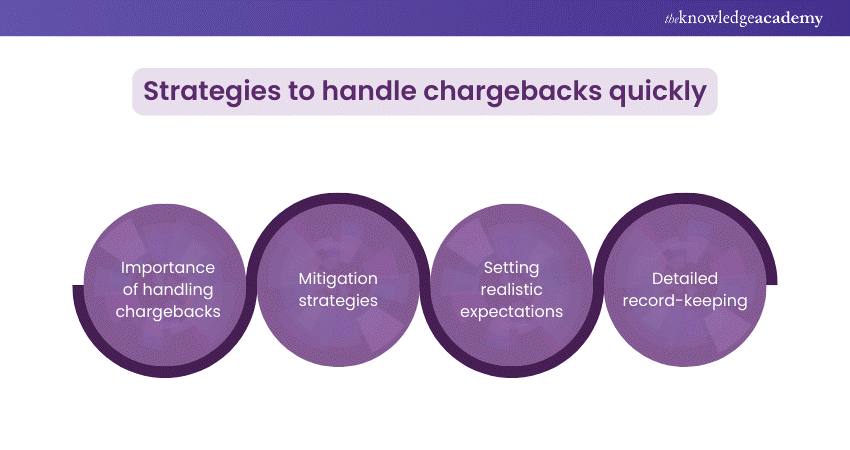
Importance of handling chargebacks:
Handling chargebacks swiftly is essential for maintaining positive customer relationships and minimising financial losses in Dropshipping. Chargebacks occur when customers dispute a transaction directly with their bank.
Mitigation strategies:
To mitigate chargebacks, clear and transparent policies regarding returns, refunds, and product quality are crucial. Communicate these policies effectively through your website, confirmation emails, and customer service channels.
Setting realistic expectations:
Chargebacks are frequently avoided by having reasonable expectations and offering outstanding customer support. By addressing concerns promptly and professionally, you can demonstrate your commitment to customer satisfaction.
Detailed record-keeping:
Maintaining detailed records of transactions and customer communications is invaluable during the resolution process. These records provide evidence to support your case and help you address disputes more effectively.
7) Adopt simple shipping rules
Here are the key points to consider when adopting simple shipping rules for your Dropshipping business:
Simplicity enhances customer satisfaction:
Adopting straightforward shipping rules is fundamental in fostering transparency and reducing customer confusion, ultimately bolstering overall satisfaction. When shipping policies are easy to grasp, customers can better comprehend the associated costs and delivery timelines, resulting in fewer grievances and inquiries.
Flat-rate shipping: streamlining logistics:
Customer decision-making can be made a lot easier by using a standard shipping strategy, which charges the same delivery amount for all orders, regardless of size or destination. This approach not only makes it easier for customers to anticipate costs but also streamlines logistics on the seller's end, reducing complexity in fulfilment operations.
Free shipping as an incentive:
Offering free shipping incentivises larger orders and attracts customers. While it may seem costly initially, it can be strategically applied to orders above a certain amount, offsetting expenses while boosting satisfaction and encouraging increased purchases. This ultimately results in balancing financial and customer satisfaction concerns.
Join our Product Content For E-Commerce Training for expert guidance- register now and boost your online sales!
8) Automate order processing
Here's how automating order processing can benefit your Dropshipping business:
Streamlining operations with automation:
Automating order processing is a pivotal strategy for Dropshipping businesses that aims to revolutionise efficiency and accuracy. By integrating cutting-edge software solutions and seamlessly syncing with suppliers, companies can optimise the entire order fulfilment process.
Efficient order transmission:
Automated systems facilitate swift and error-free order transmission directly to suppliers as soon as a customer places an order. This ensures that orders are handled precisely and swiftly by taking away the need for human involvement.
Enhanced customer satisfaction:
The seamless communication between automated systems and suppliers significantly reduces shipping times, ultimately enhancing customer satisfaction. Customers receive their orders swiftly and reliably, leading to positive experiences and potentially repeat business.
Tools for automation:
Utilising tools such as Shopify's Automatic Order Processing or Oberlo can streamline and simplify the automation process. These platforms seamlessly integrate with your existing systems, making it easy to implement automated order processing.
Focus on growth:
By automating order processing, business owners can redirect their focus from labour-intensive tasks to growth strategies and customer service. This shift allows for greater scalability and efficiency, empowering businesses to expand their operations without being hindered by manual processes.
9) Monitor your inventory
The following are the key aspects to remember when monitoring your inventory:
Inventory accuracy for customer satisfaction:
Offering free shipping incentivises larger orders and attracts customers. While it may seem costly initially, it can be strategically applied to orders above a certain amount, offsetting expenses while boosting satisfaction and encouraging increased purchases, thus balancing financial and customer satisfaction concerns.
Logistical efficiency and strategic planning:
Effective inventory management not only prevents logistical headaches but also facilitates strategic planning. Maintaining accurate stock records ensures smooth operations and minimises the risk of overselling or underselling products. Moreover, it aids in maintaining the reliability and credibility of the Dropshipping business, fostering trust and loyalty among customers.
10) Consider branded Dropshipping
Branded Dropshipping is a tactical modification of the popular Dropshipping models aimed at creating a strong brand image. Following are the key points to consider when exploring branded Dropshipping:
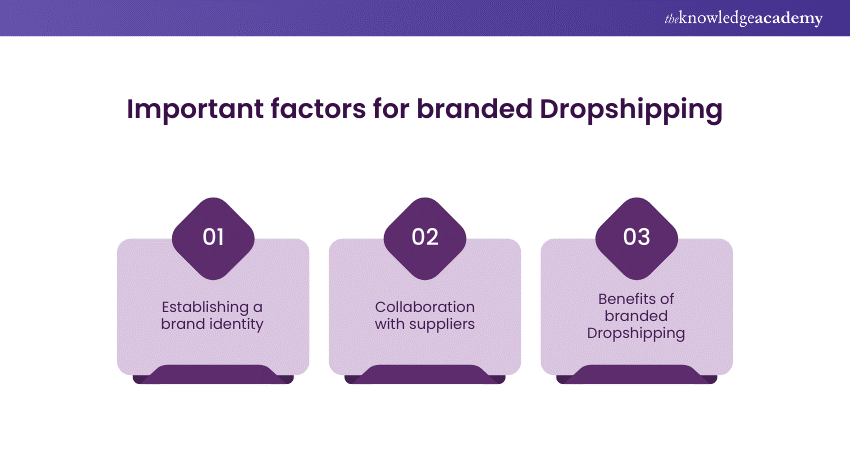
Establishing a brand identity:
In branded Dropshipping, the emphasis is on personalising the customer experience. This can include custom packaging, branded invoices, and even personalised notes within shipments. Such details make your brand memorable and encourage repeat purchases.
Collaboration with suppliers:
Having success with branded Dropshipping depends on finding suppliers who are willing to help you with your branding endeavours. This goes beyond product placement and includes the manufacturer’s determination to provide high-quality and consistent products as well as packaging. Material and supply selection is the vehicle through which a consumer interfaces with the intended brand image.
Benefits of branded Dropshipping:
Customers feel more loyal and trustworthy when a brand is established through Dropshipping, which improves the entire purchasing experience. Additionally, a strong brand can command higher prices due to perceived value and directly impact profitability. In the long run, branded Dropshipping increases customer retention and elevates your market position.
11) Make sure your website is easy to use
The following are the key components to consider when ensuring your website is user-friendly for an optimal shopping experience.
Intuitive navigation:
The cornerstone of a user-friendly website is intuitive navigation. Your site should be structured in a way that users can easily find what they're looking for without confusion. This requires an easy-to-navigate menu structure, logical product classifications, and efficient search features. Each page should guide visitors smoothly to the next step in their shopping journey.
Fast checkout process:
A fast and simple checkout process is crucial. Simplify forms, provide multiple payment options, and ensure the checkout is secure. A streamlined checkout reduces cart abandonment and enhances the overall user experience.
Accessible information:
Information accessibility is another key aspect. Product descriptions, shipping information, return policies, and customer service contacts should be easy to find. Use clear, concise language and ensure your site is responsive across devices, adapting seamlessly to desktops, tablets, and smartphones.
Discover the latest strategies in our Direct Marketing Training - sign up now for actionable insights!
12) Prioritise marketing
Following are the key strategies to prioritise marketing in your Dropshipping business:
Search Engine Optimisation (SEO):
This technique enhances your website's visibility in search engine results. You may increase traffic from search engines by optimising your website with appropriate keywords, meta descriptions, and excellent content. Regular updates and optimising for mobile devices are crucial to stay competitive.
Content marketing:
Through engaging, informative content, you can establish your brand as an authority in your niche. Blogs, how-to guides, and videos not only provide value to your audience but also improve SEO. Consistently delivering fresh content keeps your audience engaged and encourages repeat visits.
Social media:
Platforms like Facebook, Instagram, and Twitter are invaluable for connecting with your target audience. Regular posts, interactive content, and paid advertisements can help to build your brand's presence and direct traffic to your website.
Pay-Per-Click (PPC) campaigns:
PPC ads are a fast way to drive traffic. You may effectively reach potential clients who are actively searching for your items by focusing on particular demographics and keywords. Though it requires investment, PPC often yields immediate results, making it a powerful component of your marketing strategy.
Unlock the secrets of SEO mastery and propel your digital presence to new heights with our SEO Course!
13) Cash in on seasonal products and promotions
Following are the key steps to capitalise on seasonal products and promotions in Dropshipping:
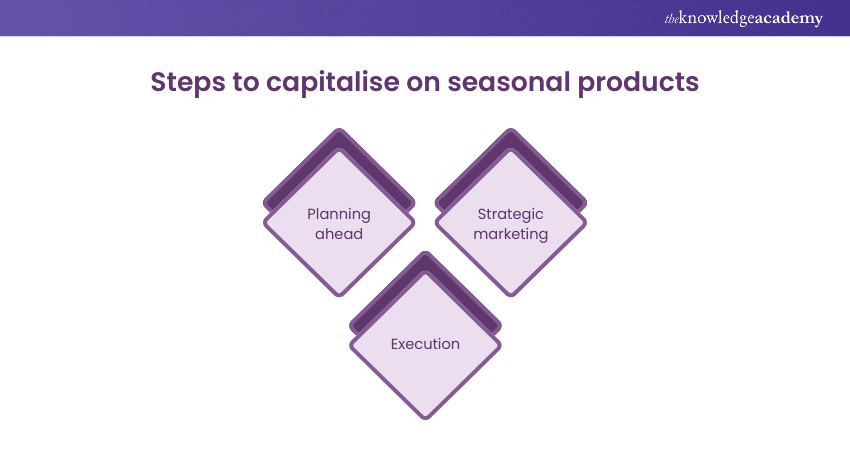
Planning ahead:
It's crucial to plan well in advance for seasonal peaks. This involves analysing previous years’ sales data and upcoming trends to forecast which products might see a surge in demand. For example, swimwear will likely be more popular in the lead-up to summer, just as decorative items spike in sales before major holidays like Christmas or Halloween.
Strategic marketing:
Once you've identified potential hot sellers, the next step is to craft targeted marketing campaigns. This could involve themed promotions, special discounts, or exclusive bundles that appeal directly to the seasonal shopper’s mindset. You can efficiently reach a larger audience by using several marketing channels, such as pay-per-click advertising, social media, and email newsletters, to boost your seasonal goods.
Execution:
The execution of your seasonal strategy should focus on timely launches, engaging content, and ensuring that your website is optimised for both traffic surges and mobile shopping. It’s also vital to coordinate closely with your suppliers to ensure stock availability matches the anticipated demand, thereby maximising the opportunity each season presents.
Elevate your social media game and become a digital influencer with our expert-led Social Media Marketing Course!
Conclusion
These Dropshipping Tips illuminate the path to success, empowering entrepreneurs to chart their course with confidence in the dynamic world of e-commerce. With strategic planning and continuous adaptation, they can set sail and conquer the waves of opportunity.
Transform your Digital Marketing skills with our Digital Marketing Courses - sign up now to boost your career!
Frequently Asked Questions

Ensure Dropshipping success by focusing on product quality, efficient supplier partnerships, strategic pricing, effective marketing, and seamless customer experience. Continuous adaptation and learning are also crucial for sustained success.

Creating a successful Dropshipping business involves selecting quality products, reliable suppliers, strategic pricing, effective marketing, and seamless customer service. Staying adaptable and continually refining your strategies also aid in sustained growth.

The Knowledge Academy takes global learning to new heights, offering over 30,000 online courses across 490+ locations in 220 countries. This expansive reach ensures accessibility and convenience for learners worldwide.
Alongside our diverse Online Course Catalogue, encompassing 17 major categories, we go the extra mile by providing a plethora of free educational Online Resources like News updates, Blogs, videos, webinars, and interview questions. Tailoring learning experiences further, professionals can maximise value with customisable Course Bundles of TKA.

The Knowledge Academy’s Knowledge Pass, a prepaid voucher, adds another layer of flexibility, allowing course bookings over a 12-month period. Join us on a journey where education knows no bounds.

The Knowledge Academy offers various Digital Marketing Courses, including Dropshipping Training Course, Digital Marketing Course, Social Media Marketing Course and SEO Course. These courses cater to different skill levels, providing comprehensive insights into Send Out a Newsletter on Gmail.
Our Digital Marketing Blogs cover a range of topics related to Dropshipping, offering valuable resources, best practices, and industry insights. Whether you are a beginner or looking to advance your Digital Marketing Skills, The Knowledge Academy's diverse courses and informative blogs have you covered.
Upcoming Digital Marketing Resources Batches & Dates
Date
 Dropshipping Training Course
Dropshipping Training Course
Fri 24th Jan 2025
Fri 21st Mar 2025
Fri 2nd May 2025
Fri 27th Jun 2025
Fri 29th Aug 2025
Fri 3rd Oct 2025
Fri 5th Dec 2025







 Top Rated Course
Top Rated Course



 If you wish to make any changes to your course, please
If you wish to make any changes to your course, please


